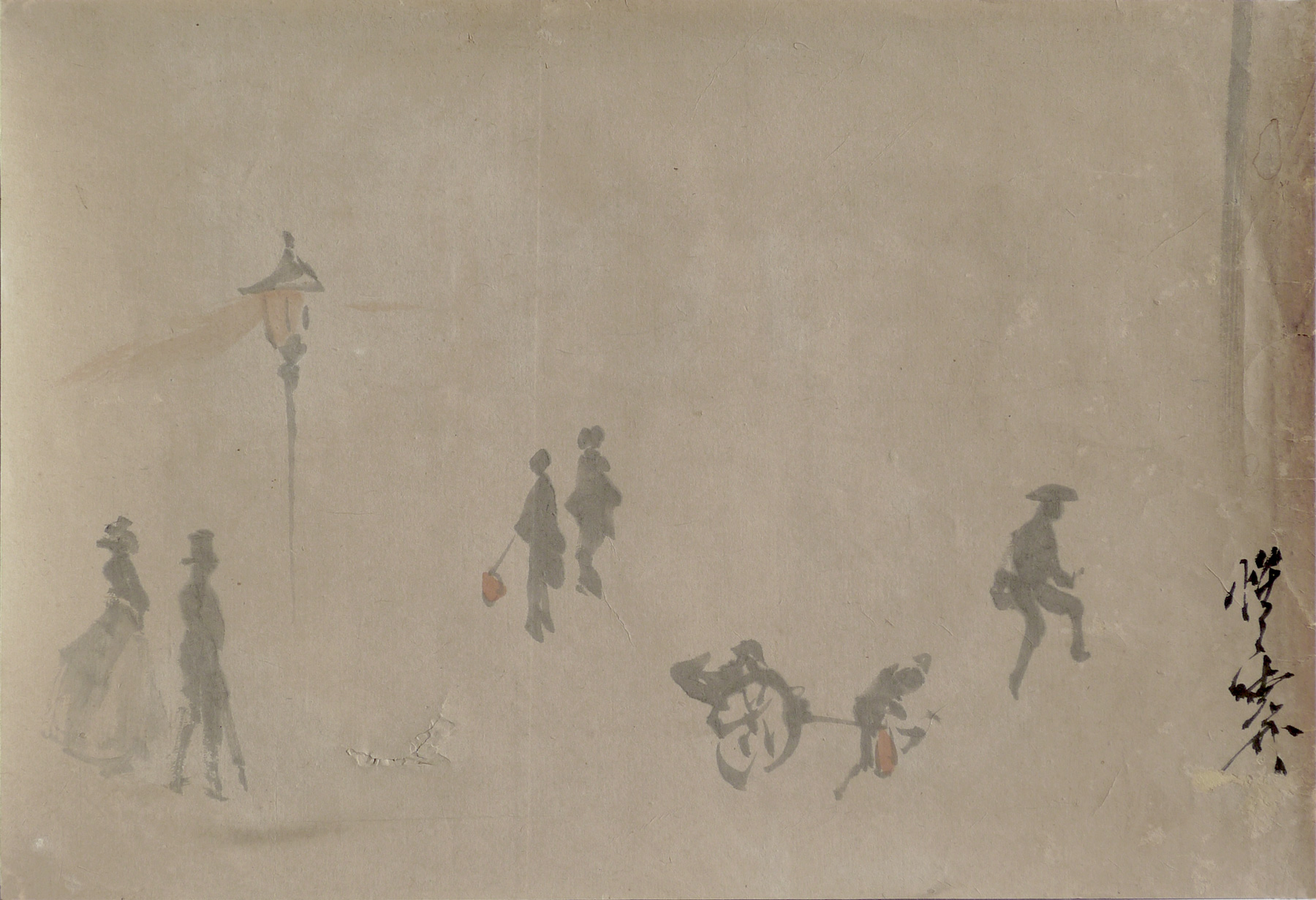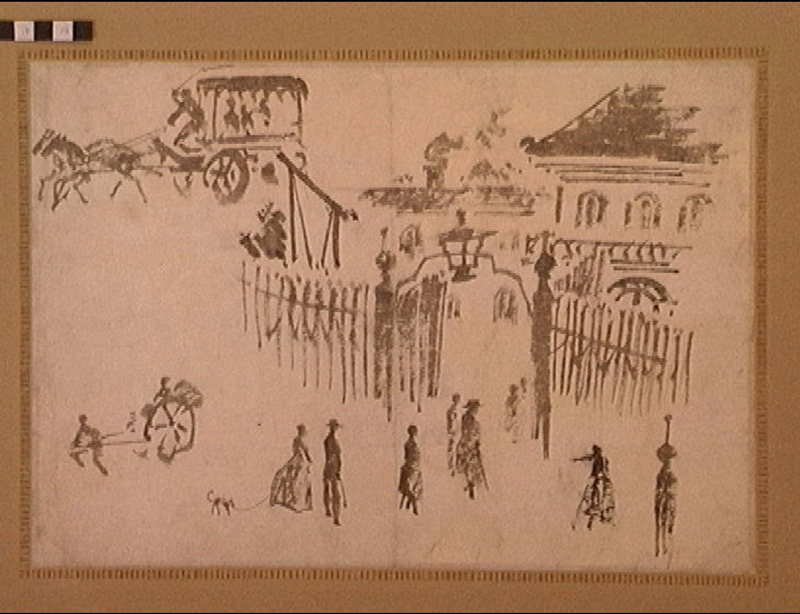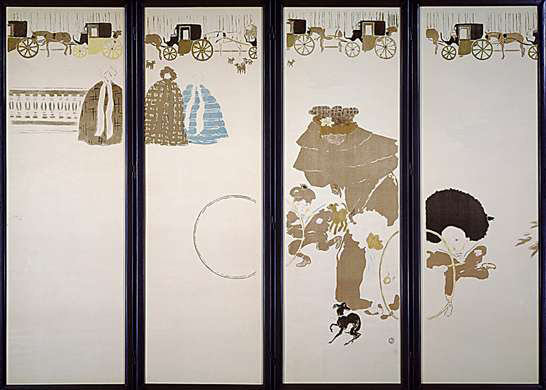About This Drawing
This Kyōsai study of silhouetted figures and gas lamps may be a preparatory drawing for a fuller scene, titled Customs House at Yokohama (pictured below), in the collection of the Rijksmuseum voor Volkenkunde, according to an email I received from Professor Matthi Forrer, curator at the National Museum of Ethnology (Museum Volkenkunde) in Leiden, in response to my inquiry. Note, in particular, the re-use of the jinrikishaw and the Western-dressed lady and gentleman in the fuller drawing.I had also remarked in my email on the bold signature on this sheet to which Professor Forrer replied. "The signature on your sheet is usually read Shojo Kyosai. Normally one wouldn’t expect a sketchy sheet like this to be signed, however. It is therefore quite likely that someone watching Kyosai drawing asked the artist to sign it."
Western Street in Yokohama (a.k.a. Customs House at Yokohama)
Rijksmuseum voor Volkenkunde
Westers straatbeeld in Yokohama (Western Street in Yokohama)
inventarisnummer: 3513-1347
vervaardiging:Kawanabe Kyosai
materiaal/techniek:inkt op papier; tekening (drawing)
afmetingen: 25,9 x 37 cm (10 7/16 x 14 13/16 in.)
datering: 1870 / 1875
signatuur: Ongesigneerd (unsigned)
inscripties: geen (none)
Note: English translations in () are my own.
The website of the Rijksmuseum voor Volkenkunde provides the following description of Western Street in Yokohama:Westers straatbeeld in Yokohama (Western Street in Yokohama)
inventarisnummer: 3513-1347
vervaardiging:Kawanabe Kyosai
materiaal/techniek:inkt op papier; tekening (drawing)
afmetingen: 25,9 x 37 cm (10 7/16 x 14 13/16 in.)
datering: 1870 / 1875
signatuur: Ongesigneerd (unsigned)
inscripties: geen (none)
Note: English translations in () are my own.
| At first sight the sketch illustrated here will probably seem completely out of place in this publication. It not only suggests a fin-de-siecle impression of London or Paris but in addition a direct connection can even be established with the four-panel screen 'La promenade des nourrices' (pictured on left) by Bonnard, situated near the Tuileries, place de la Concorde, a work dating from 1899. But what we have here is a sketch by the Japanese painter Kawanabe Kyosai (1831-89). Originally a pupil of Utagawa Kuniyoshi and later trained in various traditional schools Kyosai developed into a highly versatile and independent artist. His sharp analysis of Japanese painting styles and particularly the historical development of the schools within the ukiyoe school of painting can be judged from the four-volume Kyosaigadan published in 1887. In this book he also discussed Western drawing techniques, in which he was very interested. In contrast with many of his contemporaries, however, Kyosai did not directly imitate the art to which Japan was exposed after it was opened to the world in 1854. He attempted instead to apply it harmoniously when adaptation could play a functional role in his work. Purely traditional themes - sometimes treated in an eccentrically humorous fashion - always formed an important element in that work. As already mentioned, this sketch exudes an unmistakable Western atmosphere. In the first instance this effect was of course determined by the artist, but it was also due to the typically Western building, probably one of those erected from 1860 on along the wharves of the port of Yokohama. This city acquired a key position after the opening up of Japan, because traders from many Western countries established their headquarters there. This led to swift changes in the appearance of the streets; a rail connection was also built and despite the strong opposition of conservative elements, the inhabitants of the city quickly accepted the wearing of Western clothing and other novelties. This makes it difficult to say whether the figures in the sketch are Japanese or Westerners. Compared with the many pictures called Yokohama prints which were distributed throughout Japan on a large scale, this sketch is characterised by great spontaneity, which is hardly surprising for an artist like Kyosai. Its spontaneity has unquestionably contributed to the special appreciation shown for it in the West where sketches are generally valued much more highly than they are in Japan. |
| The drawings of Kyosai bring us almost to modern times, to a period when European influences were first freely admitted to Japan. At times, one almost feels that Kyosai is painting with one eye on the admiring foreigner, out to astound by his virtuosity (first hand accounts of foreign visitors prove that this is far from fanciful); in any case, many of his drawings do exhibit a superb mastery – they are vivacious, droll, exuberant. He is one of the great exponents of diablerie, for which Japanese artists have often shown a weakness, pursuing the grotesque, the macabre, and the ghostly with all the inexhaustible extravagance of Bosch or the Bibieans. But at his greatest – in the strangely presentimental Customs House at Yokohama, with the intimacy of the Nabis and the everyday eventfulness of T. S. Lowry; or in the splendidly expressionistic Falling Postman – Kyosai assumes the stature of an artist of the world, not merely of Japan. |
1 Sherwood Publishers, 1965; ref. fig. 6 with text on p. 30.
Drawing Details
| IHL Catalog | #667 |
| Title or Description | untitled - Study of Gaslight and Silhouetted Figures |
| Artist | Kawanabe Kyōsai (1831-1889) |
| Signature |  |
| Seal of the Artist | not sealed |
| Publication Date | between 1870-1875 based upon similar drawing, as discussed above |
| Publisher | not applicable |
| Carver | not applicable |
| Printer | not applicable |
| Impression | not applicable |
| Colors | good - likely some fading |
| Condition | fair - tears and thinning repaired from back; entire sheet is backed; overall toning |
| Genre | ukiyo-e |
| Miscellaneous | |
| Format | vertical oban |
| H x W Paper | 9 7/8 x 14 in. (25.1 x 35.6 cm) |
| H x W Image | |
| Collections This Work | for similar drawing see Rijksmuseum voor Volkenkunde online database, inventory number 3513-1347 |
| Reference Literature | the similar drawing titled Western Street in Yokohama or Customs House at Yokohama is pictured in Drawings of the Masters-Japanese Drawings from the 17th through the 19th century, J. R. Hillier, fig. 6 with text on p. 30; Japansche teekeningen en schetsen, Frans Halsmuseum, Haarlem 1938 (Cat.85, p.31); Japanese drawings of the 18th and 19th centuries, Japan House Gallery, New York 1980, (Cat.134); Aquarelles et dessins japonais des 18e et 19e siecles, Musee d'lxelles, Bruxelles 1981-2 (Cat.159). |
7/27/2021




